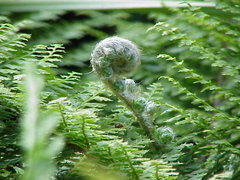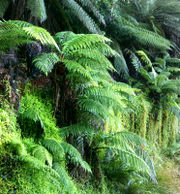Fern
2007 Schools Wikipedia Selection. Related subjects: Plants
| iFerns (Pteridophyta) | ||||
|---|---|---|---|---|
 Polystichum setiferum showing unrolling young frond
|
||||
| Scientific classification | ||||
|
||||
|
|
||||
|
Marattiopsida |
A fern is any one of a group of about 20,000 species of plants classified in the phylum or division Pteridophyta, also known as Filicophyta. The group is also referred to as polypodiophyta, or polypodiopsida when treated as a subdivision of tracheophyta (vascular plants). The study of ferns is called pteridology; one who studies ferns is called a pteridologist. The term pteridophytes has traditionally been used to describe all seedless vascular plants so is synonymous with "ferns and fern allies". This can be confusing given that the fern phylum Pteridophyta is also sometimes referred to as pteridophytes.
A fern is a vascular plant that differs from the more primitive lycophytes in having true leaves (megaphylls), and from the more advanced seed plants ( gymnosperms and angiosperms) in lacking seeds. Like all vascular plants, it has a life cycle, often referred to as alternation of generations, characterised by a diploid sporophytic and a haploid gametophytic phase. Unlike the gymnosperms and angiosperms, in ferns the gametophyte is a free-living organism. The life cycle of a typical fern is as follows:
- A sporophyte ( diploid) phase produces haploid spores by meiosis;
- A spore grows by cell division into a gametophyte, which typically consists of a photosynthetic prothallus
- The gametophyte produces gametes (often both sperm and eggs on the same prothallus) by mitosis
- A mobile, flagellate sperm fertilizes an egg that remains attached to the prothallus
- The fertilized egg is now a diploid zygote and grows by mitosis into a sporophyte (the typical "fern" plant).
Fern structure
Like the sporophytes of seed plants, those of ferns consist of:
- Stems: Most often an underground creeping rhizome, but sometimes an above-ground creeping stolon (e.g., Polypodiaceae), or an above-ground erect semi-woody trunk (e.g., Cyatheaceae) reaching up to 20 m in a few species (e.g., Cyathea brownii on Norfolk Island and Cyathea medullaris in New Zealand).
- Leaf: The green, photosynthetic part of the plant. In ferns, it is often referred to as a frond, but this is because of the historical division between people who study ferns and people who study seed plants, rather than because of differences in structure. New leaves typically expand by the unrolling of a tight spiral called a crozier or fiddlehead. This uncurling of the leaf is termed circinate vernation. Leaves are divided into two types:
- Trophophyll: A leaf that does not produce spores, instead only producing sugars by photosynthesis. Analogous to the typical green leaves of seed plants.
- Sporophyll: A leaf that produces spores. These leaves are analogous to the scales of pine cones or to stamens and pistil in gymnosperms and angiosperms, respectively. Unlike the seed plants, however, the sporophylls of ferns are typically not very specialized, looking similar to trophophylls and producing sugars by photosynthesis as the trophophylls do.
- Roots: The underground non-photosynthetic structures that take up water and nutrients from soil. They are always fibrous and are structurally very similar to the roots of seed plants.
The gametophytes of ferns, however, are very different from those of seed plants. They typically consist of:
- Prothallus: A green, photosynthetic structure that is one cell thick, usually heart- or kidney-shaped, 3-10 mm long and 2-8 mm broad. The thallus produces gametes by means of:
- Antheridia: Small spherical structures that produce flagellate sperm.
- Archegonia: A flask-shaped structure that produces a single egg at the bottom, reached by the sperm by swimming down the neck.
- Rhizoids: root-like structures (not true roots) that consist of single greatly-elongated cells, water and mineral salts are absorbed over the whole structure. Rhizoids anchor the prothallus to the soil.
Evolution and classification
Ferns first appear in the fossil record in the early-Carboniferous period. By the Triassic, the first evidence of ferns related to several modern families appeared. The "great fern radiation" occurred in the late-Cretaceous, when many modern families of ferns first appeared.
Ferns have traditionally been grouped in the Class Filices, but modern classifications assign them their own division in the plant kingdom, called Pteridophyta.
Traditionally, three discrete groups of plants have been considered ferns: the adders-tongues, moonworts, and grape-ferns ( Ophioglossophyta), the Marattiaceae, and the leptosporangiate ferns. The Marattiaceae are a primitive group of tropical ferns with a large, fleshy rhizome, and are now thought to be a sibling taxon to the main group of ferns, the leptosporangiate ferns. Several other groups of plants were considered " fern allies": the clubmosses, spikemosses, and quillworts in the Lycopodiophyta, the whisk ferns in Psilotaceae, and the horsetails in the Equisetaceae. More recent genetic studies have shown that the Lycopodiophyta are only distantly related to any other vascular plants, having radiated evolutionarily at the base of the vascular plant clade, while both the whisk ferns and horsetails are as much true ferns as are the Ophioglossoids and Marattiaceae. In fact, the whisk ferns and Ophioglossoids are demonstrably a clade, and the horsetails and Marattiaceae are arguably another clade.
One possible means of treating this situation is to consider only the leptosporangiate ferns as "true" ferns, while considering the other three groups as "fern allies".
The true ferns may be subdivided into six main groups, or classes (or, if the true ferns are considered as a class, then the last three would be orders):
- Ophioglossopsida
- Equisetopsida
- Marattiopsida
- Osmundopsida
- Gleicheniopsida
- Pteridopsida
The last group includes most plants familiarly known as ferns. Modern research indicates that the Osmundopsida diverged first from the common ancestor of the leptosporangiate ferns, followed by the Gleichenopsida.
A more complete classification scheme follows:
- Division: Pteridophyta
- Class: Ophioglossopsida
- Order: Ophioglossales
- Order: Psilotales
- Class: Equisetopsida
- Order: Equisetales
- Class: Marattiopsida
- Order: Marattiales
- Order: Christenseniales
- Class: Osmundopsida
- Order: Osmundales (the flowering ferns)
- Class: Gleicheniopsida
- Subclass: Gleicheniatae
- Order: Gleicheniales (the forked ferns)
- Order: Dipteridales
- Order: Matoniales
- Subclass: Hymenophyllatae
- Order: Hymenophyllales (the filmy ferns)
- Subclass: Hymenophyllopsitae
- Order: Hymenophyllopsidales
- Subclass: Gleicheniatae
- Class: Pteridopsida
- Subclass: Schizaeatae
- Order: Schizeales (including the climbing ferns)
- [heterosporous ferns]
- Order: Marsileales (Hydropteridales) (the water-clovers, mosquito fern, water-spangle)
- Subclass: Cyatheatae
- Order: Cyatheales (the tree ferns)
- Order: Plagiogyriales
- Order: Loxomales
- Subclass: Pteriditae
- Order: Lindseales
- Order: Pteridales (including the brakes and maidenhair ferns)
- Order: Dennstaedtiales (the cup ferns, including bracken)
- Subclass: Polypoditae
- Order: Aspleniales (the spleenworts)
- Order: Athyriales (including the lady ferns, ostrich fern, maiden ferns, etc.)
- Order: Dryopteridales (the wood ferns and sword ferns)
- Order: Davalliales (including the rabbits-foot ferns and Boston ferns)
- Order: Polypodiales (including the rock-cap ferns or Polypodies)
- Subclass: Schizaeatae
- Class: Ophioglossopsida
Economic uses
Ferns are not as important economically as seed plants but have considerable importance. Ferns of the genus Azolla are very small, floating plants that do not look like ferns. Called mosquito fern, they are used as a biological fertilizer in the rice paddies of southeast Asia, taking advantage of their ability to fix nitrogen from the air into compounds that can then be used by other plants. A great many ferns are grown in horticulture as landscape plants, for cut foliage and as houseplants, especially the Boston fern (Nephrolepis exaltata). Several ferns are noxious weeds or invasive species, including Japanese climbing fern ( Lygodium japonicum), mosquito fern and sensitive fern (Onoclea sensibilis). Giant water fern ( Salvinia molesta) is one of the world's worst aquatic weeds. The important fossil fuel coal consists of the remains of primitive plants, including ferns.
Other ferns with some economic significance include:
- Dryopteris filix-mas (male fern), used as a vermifuge
- Rumohra adiantoides (floral fern), extensively used in the florist trade
- Osmunda regalis (royal fern) and Osmunda cinnamomea (cinnamon fern), the root fibre being used horticulturally; the fiddleheads of O. cinnamomea are also used as a cooked vegetable
- Matteuccia struthiopteris (ostrich fern), the fiddleheads used as a cooked vegetable in North America
- Pteridium aquilinum (bracken), the fiddleheads used as a cooked vegetable in Japan and are believed to be responsible for the high rate of stomach cancer in Japan
- Diplazium esculentum (vegetable fern), a source of food for some native societies
- Pteris vittata (brake fern), used to absorb arsenic from the soil
- Polypodium glycyrrhiza (licorice fern), roots chewed for their pleasant flavor
- Tree ferns, used as building material in some tropical areas
- Bracken fern, often poisons cattle and horses
- Cyathea cooperi (Australian tree fern), an important invasive species in Hawaii
- Dryopteris filix-mas, this fern accidentally sprouting in a bottle resulted in Nathaniel Bagshaw Ward's 1829 invention of the terrarium or Wardian case
- Ceratopteris richardii, a model plant for teaching and research, often called C-fern
Cultural connotations
In Slavic folklore, ferns are believed to bloom once a year, during the Ivan Kupala night. Although it's exceedingly difficult to find, anyone who takes a look of a fern-flower will be happy and rich for the rest of his life. Similarly in Finland, the tradition holds that one who finds the seed of a fern in bloom on Midsummer night, will by the posession of it be able to travel under a glamour of invisibility and shall be guided to the locations where eternally blazing Will o' the wisps mark the spot of hidden treasure caches.
Misunderstood names
Several non-fern plants are called "ferns" and are sometimes popularly believed to be ferns in error. These include:
- "Asparagus fern" - This may apply to one of several species of the monocot genus Asparagus, which are flowering plants. A better name would be "fern asparagus".
- "Sweetfern" - This is a shrub of the genus Comptonia.
- " Air fern" - This is an unrelated aquatic animal that is related to a coral; it is harvested, dried, dyed green, then sold as plant that can "live on air". It looks like a fern but is actually a skeleton.
In addition, the book Where the Red Fern Grows has elicited many questions about the mythical "red fern" named in the book. There is no such known plant, although there has been speculation that the Oblique grape-fern, Sceptridium dissectum, could be referred to here, because it is known to appear on disturbed sites and its fronds may redden over the winter.
Gallery
|
Unidentified fern with spores showing in Rotorua, NZ. |










